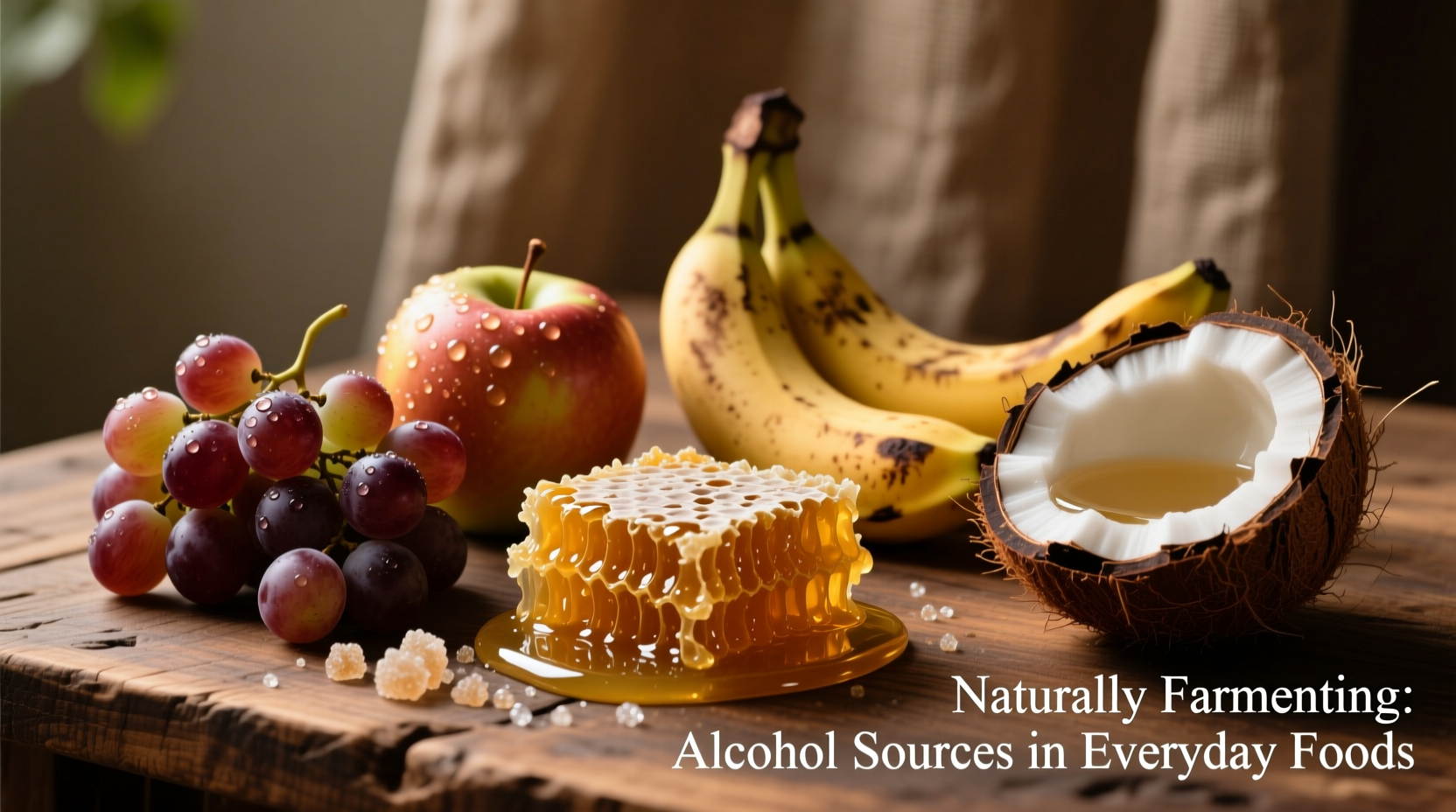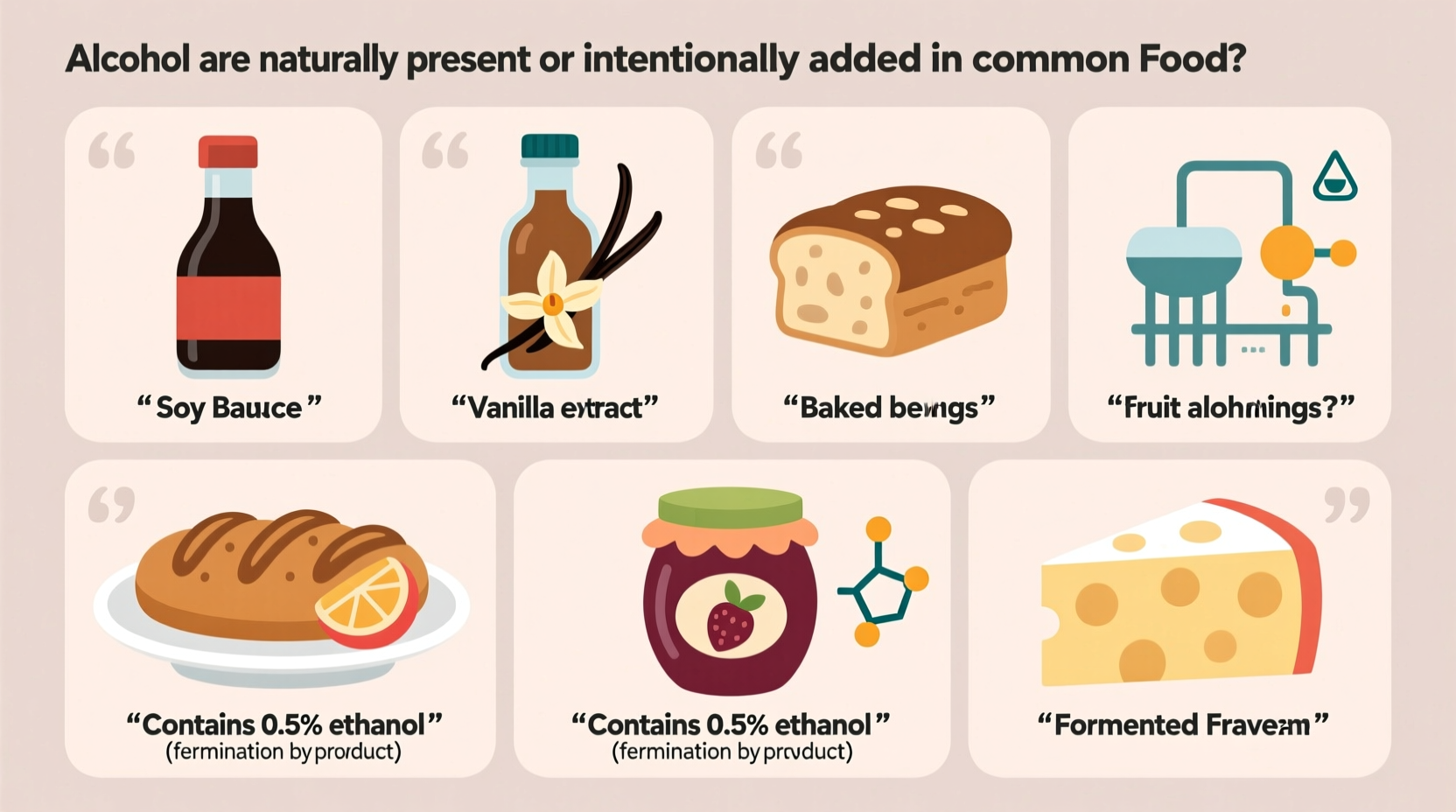Understanding which foods contain alcohol matters whether you're following religious dietary restrictions, managing health conditions, supporting someone in recovery, or simply curious about what's in your meals. This guide reveals exactly where alcohol appears in everyday foods, how much is typically present, and what it means for your dietary choices.
How Alcohol Naturally Forms in Everyday Foods
Contrary to popular belief, alcohol isn't just something added to foods—it often forms naturally through microbial activity. When yeasts encounter sugars in fruits, grains, or other carbohydrates, they produce ethanol as a metabolic byproduct in a process called fermentation. This natural occurrence explains why seemingly non-alcoholic foods contain trace amounts of alcohol.
While ethanol dominates food-related alcohol content, other alcohols like methanol (in small amounts in fruit juices) and butanol (in some fermented dairy products) can occasionally appear, though these are far less common and typically present in negligible quantities.
Common Foods Containing Alcohol: What You Need to Know
Many everyday foods contain alcohol, either through natural processes or intentional addition. Here's what you'll find in your kitchen:
| Food Category | Alcohol Source | Typical Alcohol Content | Notes |
|---|---|---|---|
| Bread & Baked Goods | Natural yeast fermentation | 0.01-1.9% ABV | Most evaporates during baking; higher in sourdough and artisan breads |
| Ripe Fruits | Natural fruit fermentation | 0.01-0.7% ABV | Higher in overripe bananas, apples, and grapes |
| Vinegar | Fermentation byproduct | Trace amounts | Alcohol converts to acetic acid during production |
| Soy Sauce & Fermented Condiments | Brewing process | 0.1-2% ABV | Traditional brewing methods retain more alcohol |
| Cooking Sauces & Desserts | Intentional addition | Varies widely | Wine, beer, or spirits added during preparation |

Understanding Alcohol Levels: When Should You Be Concerned?
The alcohol content in most naturally occurring food sources falls well below levels that would affect sobriety or show on breathalyzer tests. According to research published in the Journal of Agricultural and Food Chemistry, a slice of bread typically contains less alcohol than a ripe banana, and both contain significantly less than what's found in non-alcoholic beer (which ranges from 0.05-0.5% ABV).
For context, the U.S. Food and Drug Administration considers foods containing less than 0.5% alcohol by volume as non-alcoholic. Most naturally fermented foods fall below this threshold, though some traditional fermented products like certain soy sauces or kombucha may approach or slightly exceed it.
Cooking with Alcohol: What Really Happens to the Alcohol Content?
When recipes call for wine, beer, or spirits, many assume the alcohol completely evaporates during cooking. Research from the USDA Food Safety and Inspection Service shows this isn't entirely accurate:
- After 15 minutes of simmering: 40% of alcohol remains
- After 30 minutes of simmering: 35% remains
- After 2 hours of simmering: 10% remains
- After 2.5 hours of simmering: 5% remains
The actual retention depends on multiple factors including cooking temperature, surface area exposed, and whether the alcohol was added to a hot or cold mixture. Flambé techniques, where alcohol is ignited, remove less alcohol than prolonged simmering—contrary to popular belief.
Special Dietary Considerations
Certain populations need to be particularly mindful of alcohol content in foods:
For Religious Observance
Islamic and Jewish dietary laws have specific guidelines regarding alcohol in foods. While naturally occurring trace amounts from fermentation are generally permissible in halal certification (according to the Islamic Web fatwa database), intentionally added alcohol—even if cooked off—is typically prohibited. Kashrut (kosher) standards vary by authority, with some permitting foods where alcohol was used but fully evaporated.
For Recovery and Health Conditions
Individuals in alcohol recovery programs often avoid any food containing alcohol, regardless of quantity. The Substance Abuse and Mental Health Services Administration notes that even small amounts can trigger cravings for some people. Those with alcohol dehydrogenase deficiency (common in East Asian populations) may experience flushing and discomfort from foods with higher natural alcohol content.
Practical Tips for Managing Alcohol in Your Diet
Whether you're avoiding alcohol for health, religious, or personal reasons, these strategies can help:
- Read labels carefully—"alcohol-free" doesn't always mean zero alcohol
- Ask about preparation methods when dining out
- Choose fresh over fermented products when possible
- When cooking, substitute non-alcoholic alternatives like broth, fruit juice, or vinegar-based mixtures
- Be aware that "cooked off" doesn't mean alcohol-free
Remember that most people don't need to worry about trace alcohol in everyday foods. Unless you have specific health concerns or dietary restrictions, the small amounts found in naturally fermented products pose no risk and are part of what gives these foods their distinctive flavors and textures.
Does bread contain alcohol?
Yes, bread contains trace amounts of alcohol (typically 0.01-1.9% ABV) from the yeast fermentation process. Most alcohol evaporates during baking, but small amounts remain, particularly in sourdough and artisan breads with longer fermentation times.
Can you get drunk from eating foods cooked with alcohol?
It's highly unlikely. While cooking doesn't eliminate all alcohol, the amounts remaining in properly prepared dishes are too small to cause intoxication. For example, a typical serving of food cooked with wine for 30 minutes contains less alcohol than a ripe banana.
Do ripe fruits contain alcohol?
Yes, ripe and especially overripe fruits naturally contain small amounts of alcohol (0.01-0.7% ABV) due to natural fermentation. Bananas, apples, and grapes typically have the highest levels, but these amounts are too low to affect sobriety or show on breathalyzer tests.
Is vinegar made from alcohol?
Yes, vinegar production begins with an alcoholic liquid (like wine, cider, or fermented grain mash). Bacteria then convert the alcohol (ethanol) into acetic acid through acetous fermentation. Most commercial vinegars contain only trace amounts of residual alcohol after this conversion process.
How can I cook without alcohol while maintaining flavor?
You can substitute non-alcoholic alternatives that provide similar depth: use broth instead of wine, apple cider vinegar instead of sherry, pomegranate juice instead of port, or citrus juice with a splash of vinegar for deglazing. Adding umami-rich ingredients like mushrooms or soy sauce can also compensate for flavor complexity typically provided by alcohol.











 浙公网安备
33010002000092号
浙公网安备
33010002000092号 浙B2-20120091-4
浙B2-20120091-4